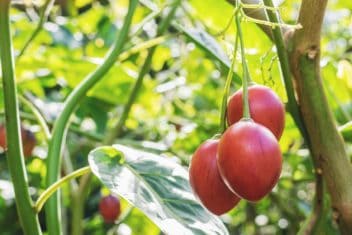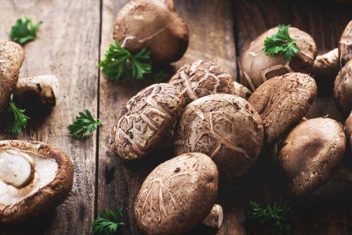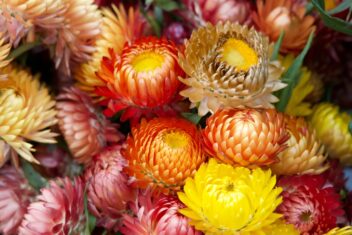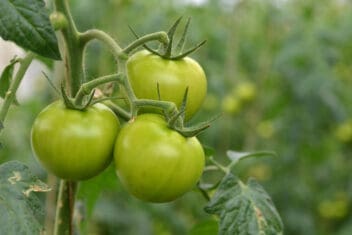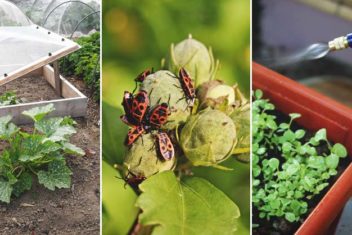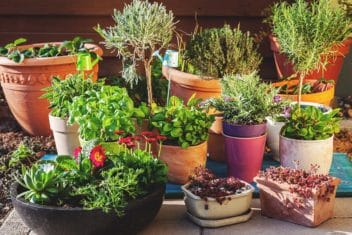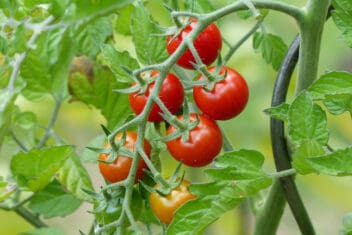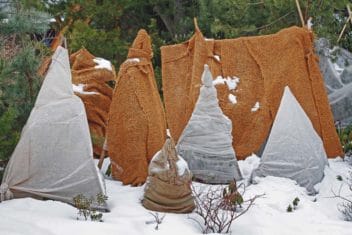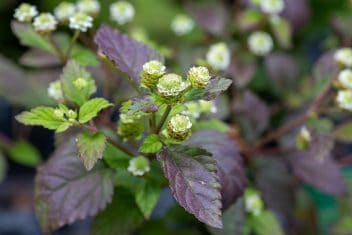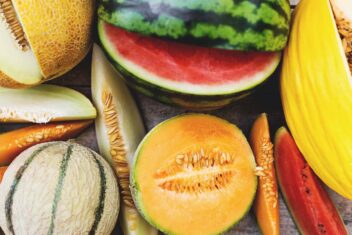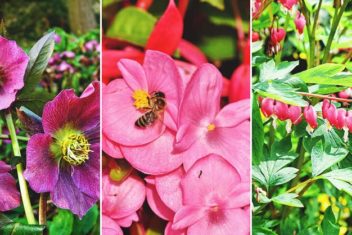Black walnuts trees are gorgeous. Their dark bark and feathery leaves look stunning against the sky in all types of weather. These trees can produce an abundance of delicious nuts as well, making them an attractive option for homesteaders and small farmers.
But black walnuts have a dark side as well. Many unsuspecting gardeners have planted black walnuts without realizing just how quickly juglone – a compound secreted by the roots of the black walnut tree – can kill neighboring plants.
Maybe you’ve innocently added black walnuts to your orchard or moved onto a property with established trees. Suddenly, you’re learning the hard way that black walnut trees don’t co-exist easily with other plants. Is there any way to fix the situation?
What is Juglone?
Essentially, juglone is a toxic compound that black walnut (Juglans nigra) produces and sends out into the soil through its roots. Juglone exists throughout the tree but primarily concentrates in the bark and roots of the tree.
This allelopathic compound exists to stunt the growth of neighboring plants, acting on the metabolic and respiratory functions of other plants, according to studies. Plants susceptible to juglone can wilt and die within 30 hours of exposure to the compound. Juglone poisoning causes leaves to wilt and turn yellow and eventually causes plants to die.
It’s a helpful trick for the walnut tree. Killing off neighboring plants allows the tree to keep all the water and nutrients in the soil for itself. Black walnuts don’t like competition.
The spread of juglone in the soil can extend to a distance equal to the height of the tree, so you might end up with a very large bare patch.
Should I Cut Down My Black Walnuts?

Some people have tried chopping down their walnut trees to clear the juglone from the soil. It’s true that the biggest concentration of juglone is under the canopy of the tree, but cutting it down won’t eliminate the problem.
Unfortunately, once the walnut tree is down, the roots continue to leech juglone into the soil for years as they decompose. Even with proper aeration and stumping, the ground that once held a black walnut tree will be laced with juglone for many years to come.
Fortunately, not all plants are sensitive to juglone. As long as you’re careful to choose juglone-hardy varieties, you can have your black walnuts and a garden too!
By the way, this list also applies to hickory trees (Carya spp.), English or Persian walnuts (J. regia), and butternuts (J. cinerea), which also contain juglone.

Flowers & Ornamental Plants Resistant to Juglone
Flowers look beautiful beneath black walnut trees. The bright blossoms against the dark trunk are stunning. Look for these hardy, juglone-resistant varieties to make a flower garden around the walnut tree.
1. Bee Balm (Monarda spp.)
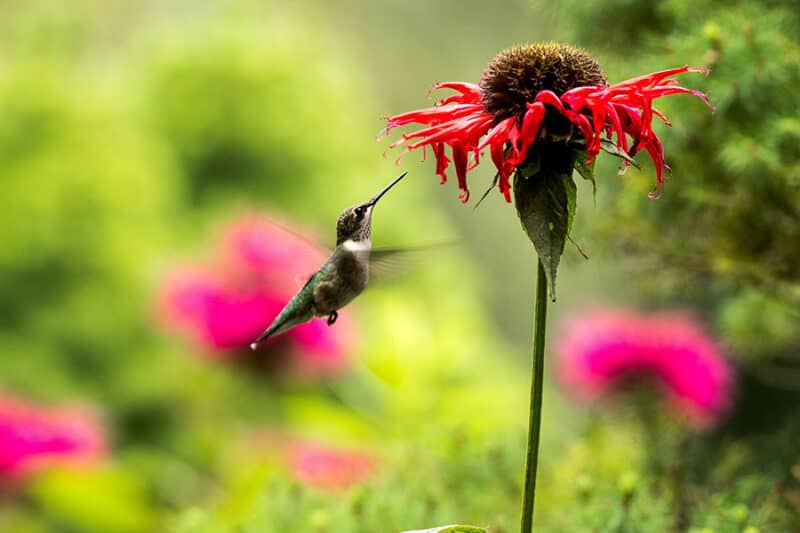
This tall, tough member of the mint family knows how to thrive everywhere in zones 4-9. It smells like bergamot and tastes fantastic in herbal tea blends. Monarda spreads quickly too, eating up all the empty space under the walnut tree. The blossoms in the summer look like tiny bonfires in bright crimson, purple, or pink.
2. Daylily (Hemerocallis spp.)
Some gardeners dismiss daylilies as mere pretty weeds, but they’re a weed that thrives in harsh environments throughout zones 4-9. Daylilies aren’t bothered by juglone or much else for that matter. They bloom and spread wherever they’re planted.
3. Kentucky Bluegrass (Poa pratensis)
This gorgeous, dark green grass is lush and softy textured. Kentucky bluegrass thrives in zones 1-8. It can grow gracefully into tall tufts or spread out into a gentle pasture. If your walnut trees abut pasture or lawn, put in some Kentucky bluegrass and watch (or imagine) your livestock grazing under the golden leaves of your black walnut tree.
4. Yarrow (Achillea millefolium)
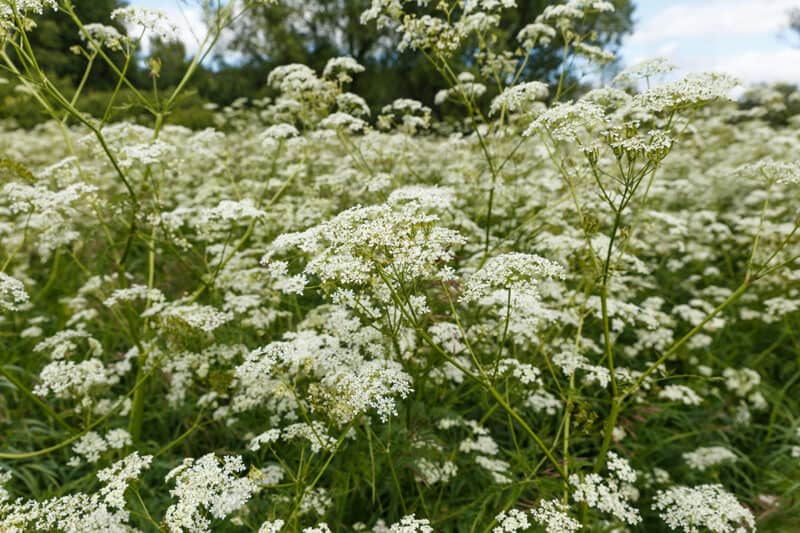
This tiny-flowered, many-leaved little wildflower is a joy in any garden. Wild yarrow has white flowers, but cultivated, it can bloom in a variety of colors. Plant some yarrow amid the Monarda because both flowers are good luck. Folklore states that poisonous plants and evil creatures can’t live in a place where yarrow grows freely.
5. Zinnia (Zinnia spp.)
There is nothing more satisfying at the end of the summer than cutting an armful of zinnias each week and filling the house with flowers. Zinnias are bright, cheerful, consistent bloomers who will fill the sunny areas around your black walnut with color until the first frost. They grow as annuals in USDA Growing Zones 2-11.
6. Wild Rose (Rosa acicularis)
Not all roses can survive near black walnut. The more cultivated varieties struggle to co-exist with juglone. But wild roses are extremely hardy, and they’re able to handle a lot that their more cultivated sisters can’t. Put some lovely wild roses near the walnut trees and enjoy the contrast of colors, textures, and scents!
7. Coneflower (Echinacea spp.)
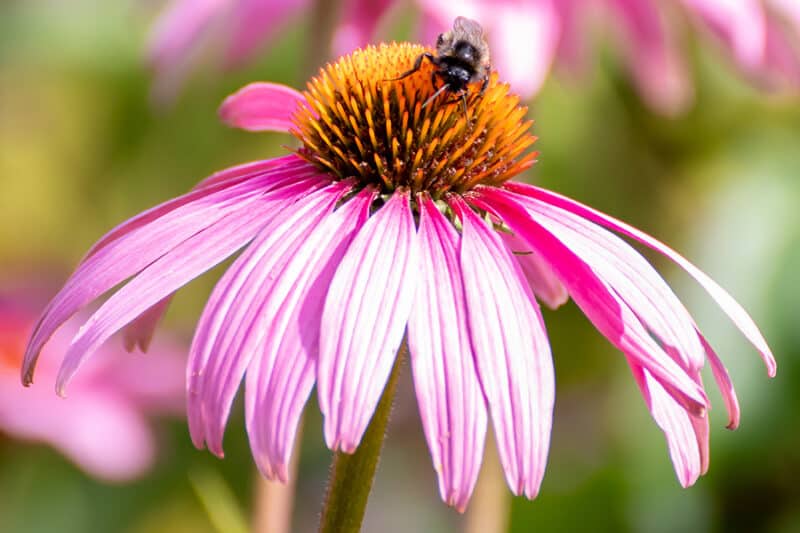
Perfect for cut flowers, coneflowers are a tall, graceful addition to any garden. They look lovely growing between daylilies and zinnias, and they don’t mind sharing garden space with black walnuts either. Coneflowers grow as perennials in Zones 3-9.
8. Wisteria (Wisteria spp.)
Wisteria is a hardy vine that isn’t susceptible to juglone.
9. Hosta (Hosta spp.)
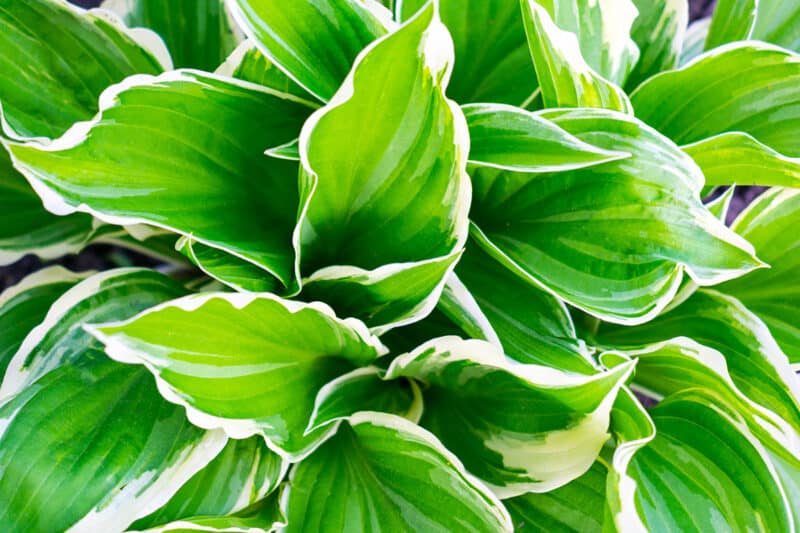
Hostas are a staple for shady gardens. Not only are the leafy stunners beautiful, with tall spikes of flowers during the summer and striking leaves from spring through fall, but the young shoots are edible, as well. Plant these right under your black walnut to add some color below the canopy.
10. Hollyhock (Alcea rosea)
Hollyhocks are part of the mallow family and they produce tall, colorful spikes of flowers.
11. Pansies and Violets (Viola spp.)
These colorful flowers are usually grown as annuals and they won’t mind one bit if you plant them near a black walnut.
Vegetables & Fruits Resistant to Juglone
Tomatoes and apple trees are famously susceptible to juglone. Because of that, most people tend to avoid planting vegetables and fruits of any kind near black walnut trees. But there are a number of juglone-resistant plants that can grow and produce well.
1. Beans (Fabaceae family)
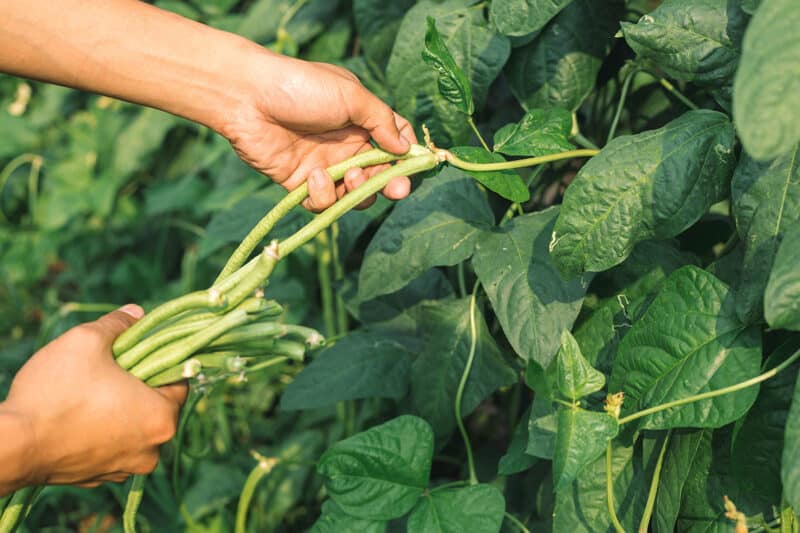
Bean plants are probably the best known juglone-friendly vegetables. All varieties – both bush and pole beans can grow successfully near black walnuts.
2. Beets (Beta vulgaris)
Most root crops will do well near walnut trees. Hardy, red beets have no trouble with the soil near black walnuts, and even the less prolific golden beets aren’t adversely affected. So go ahead and fill a bed with beets near the old walnut tree. Then, harvest your beets and walnuts, roast them together with a bit of olive oil and crumble in some goat cheese – it’s a delicious, autumnal salad.
3. Garlic (Allium sativum)
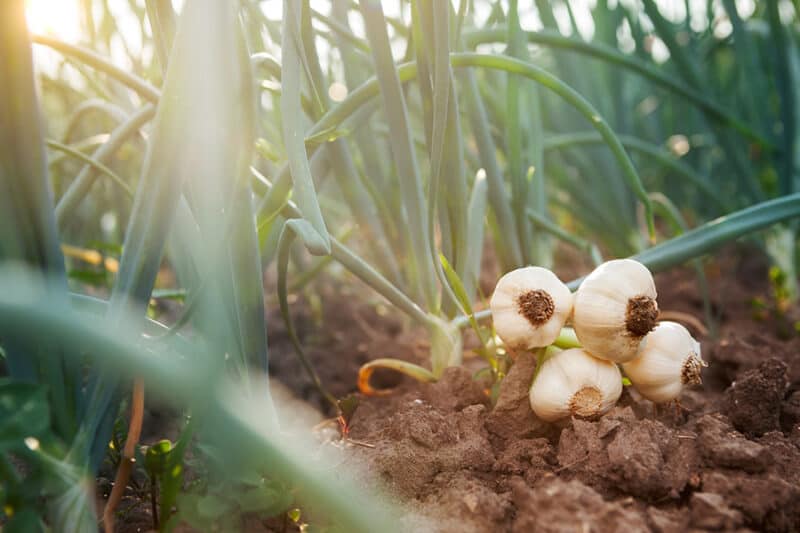
Not much will ruin garlic’s growth. It doesn’t mind juglone at all. Plant a bed of garlic near the monarda, yarrow, and walnut trees and grow a “good luck” garden.
4. Leeks, Chives, Shallots, and Onions (Allium spp.)
None of the alliums struggle with life close to walnut trees. These powerfully scented, and deeply nourishing vegetables are tough enough to enjoy growing anywhere. Fill the whole yard with alliums, you can never have too many leeks and onions – or too many walnuts.
5. Squash (Cucurbita spp.)
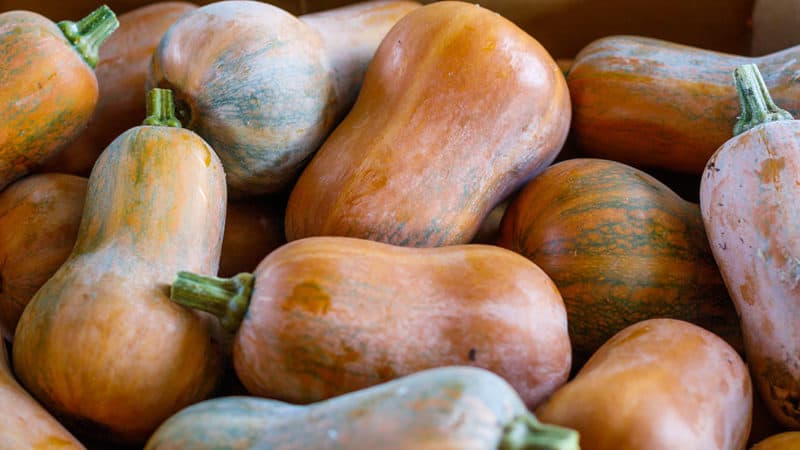
Winter squashes don’t seem to notice their neighbors, do they? This past summer, my squashes cheerfully climbed over everything in their path. They have the same careless attitude toward juglone. It doesn’t bother them at all – and they only notice your walnut trees as one more opportunity to climb.
6. Carrots (Daucus carota subsp. sativus)
Like beets, onions, and garlic, carrots are a root crop that can thrive in juglone soil. Planting beds of carrots in the area around your black walnut trees can be a great way to use space that might go to waste – and get a great harvest in the bargain.
7. Cherries (Prunus spp.)
Cherry trees are notoriously finicky. They catch diseases easily and are often beset with pests. But with all their issues, cherries don’t mind juglone at all.
8. Wheat
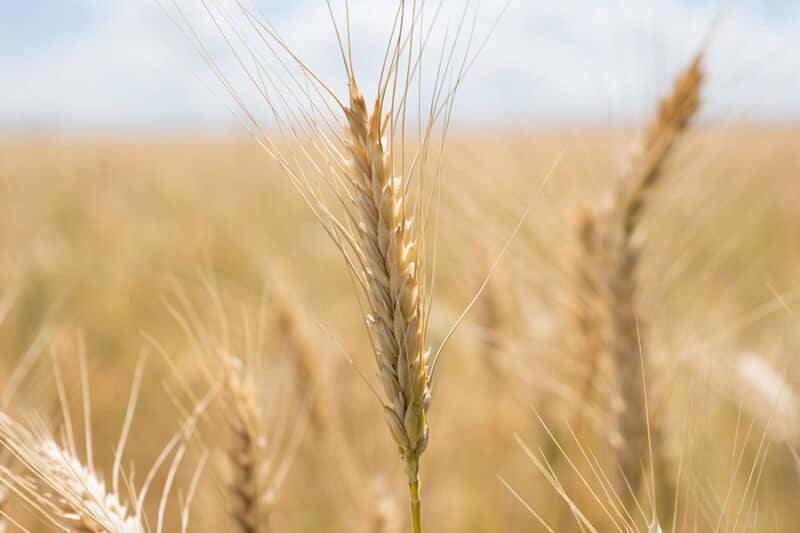
Grains seem to do well near black walnut trees. In fact, some studies show that wheat actually benefits from being planted within black walnut’s root zone. Apparently, the juglone can occasionally increase the grown of small grains like wheat.
9. Pawpaw (Asimina triloba)
Pawpaws provide massive fruits in the fall and the trees aren’t hindered by juglone in the least. The shrubby trees are beautiful in the spring with their display of flowers.
10. Persimmon (Diosypros virginiana)
The American persimmon is less popular than its Asian cousins, but it’s resistant to juglone and if you wait for the fruits to become soft on the tree, they’re extremely tasty.
11. Elderberry (Sambucus Canadensis)
Providing food, beauty, and medicine, all while being resistant to juglone, elderberries are a pretty fantastic fruit. They’re also gorgeous when they’re blooming during the springtime.
12. Black Raspberry (Rubus occidentalis)
Black raspberries taste fantastic, and they aren’t troubled by at all if you decide to grow them near black walnuts.
13. Parsnips (Pastinaca sativa)
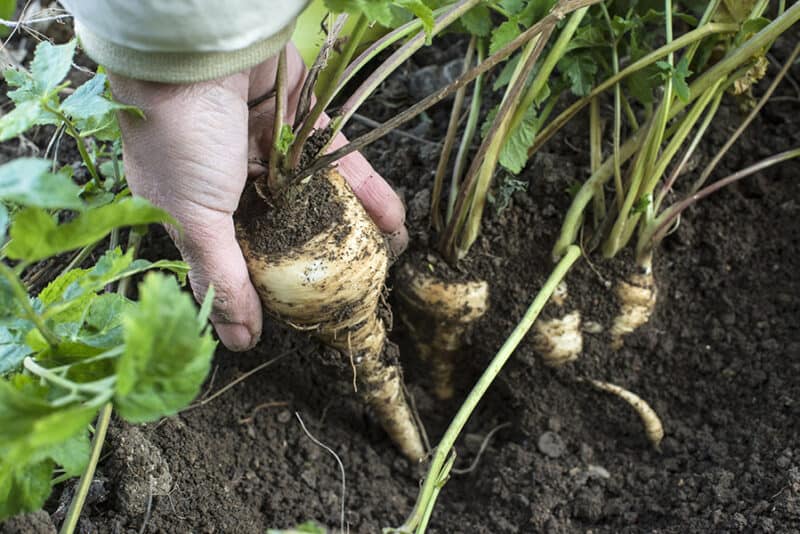
Gardeners looking for a cold weather crop know the value of parsnips already. These hardy veggies only taste better when they experience a frost or two. They’re also untroubled by growing near black walnut trees.
14. Quince (Cydonia oblongata)
Did you know that quinces are related to roses, apples, and pears? These exceptional fruits are delicious, but the trees can also be grown ornamentally because of the large, glossy leaves and the dramatic blossoms.
15. Corn (Zea mays subsp. mays)
Corn, like wheat, may actually grow better when it is planted near a juglone-producing plant.
Trees & Shrubs Resistant to Juglone
For those of us who love trees, it’s nice to know that one black walnut won’t clear the rest of the yard. There are plenty of beautiful trees that can grow alongside the unsocial walnut.
1. Hawthorn (Crataegus spp.)
I love hawthorn trees. Their long sharp thorns, beautiful blossoms, and bright red berries are a continual bright spot in the yard. They’re also delicious and healing in teas and elixirs. Like walnut trees, hawthorns know how to protect their boundaries.
2. Beech (Fagus spp.)
Beautiful beech trees can handle life near walnuts. They’re a simple, hardy tree that doesn’t mind a little juglone in the soil – and they often make fantastic climbing trees for outdoorsy kids!
3. Linden (Tilia spp.)
This gentle, flowering tree produces a beautiful wood for carving, delicious flowers for herbal teas, and a home for bees and butterflies of all kinds. Lindens bright green leaves and white flowers form a lovely contrast with black walnut’s dark bark and heavy nuts.
4. Maple (Acer spp.)
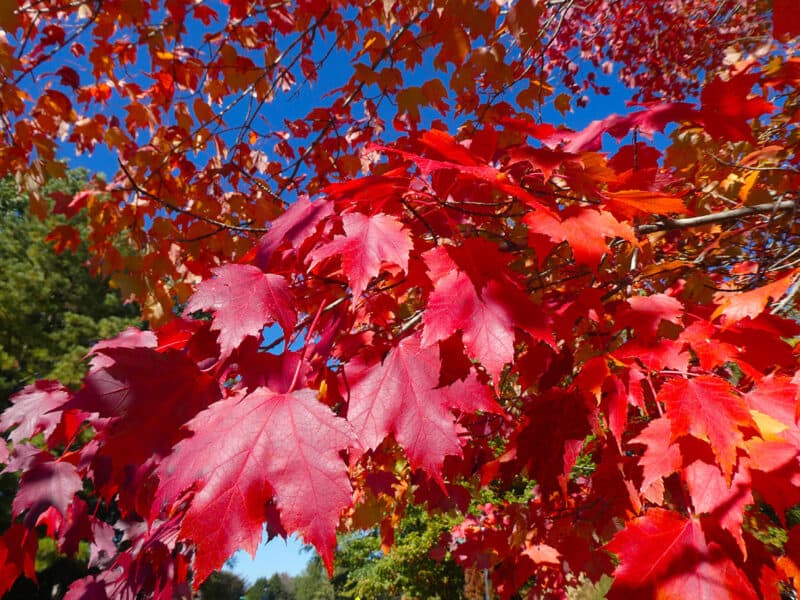
Thank goodness you can grow walnuts and maple together! Nothing tastes better than walnuts and maple syrup, so keep these two friends close. Not all maple varieties can thrive in juglone soil. Silver maple is susceptible to juglone, so stick to sugar or Japanese maples instead.
‘Bloodgood’ Japanese maple (A. palmatum var. atropurpureum ‘Bloodgood’) is a classic, well-loved cultivar that would look beautiful near your black walnut trees.
5. Forsythia
This stunning springtime shrub does just fine near black walnut trees. Its bright yellow flowers stand out beautifully against the gray-black bark of the walnut tree. Forsythia also transplants well. If you’re not sure what to do with the area around your walnut tree, fill it with forsythia for a year or two. You’ll have a beautiful garden to admire while deciding.
6. Juniper (Juniperus spp.)

Not actually a cedar, Eastern red cedar is a common wild and cultivated juniper across the eastern US. Common cedar (J. communis) grows wild across North America and there are many cultivated varieties out there you can purchase. Any species will work planted near a black walnut, however.
The low-growing, ever-popular Blue Star juniper (J. squamata ‘Blue Star’) is an excellent choice, for instance.
7. Catalpa (Catalpa bignoniodes)
Catalpas have massive leaves (and equally as massive pods), which makes them stand out in the garden. These large beauties grow well next to black walnuts and other juglone producing plants.
8. Sycamore (Platanus occidentalis)
These tall, deciduous trees are drought tolerant and juglone resistant.
8. Dogwood (Cornus alternifolia)
Dogwoods are loved for their striking flowers, which absolutely cover the trees during the spring.
9. Rose of Sharon (Hibiscus syriacus)
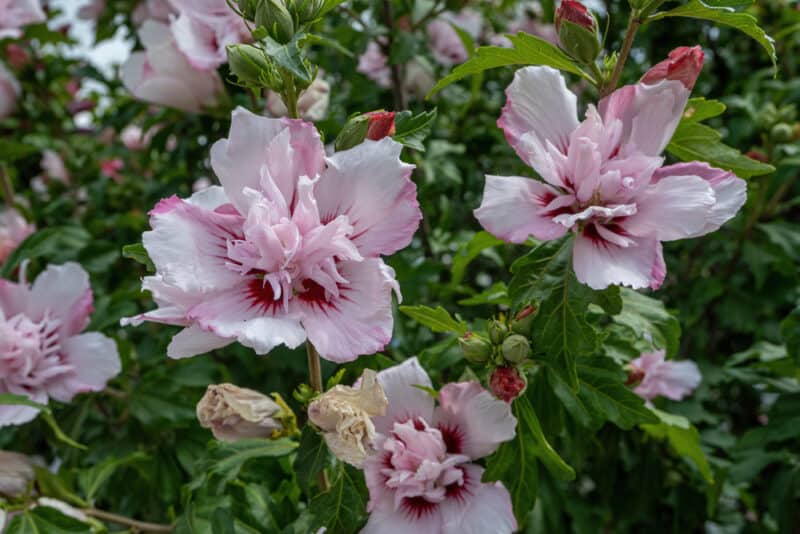
Part of the Hibiscus genus, Rose of Sharon produces large, showy, extremely colorful blossoms.
10. American Holly (Ilex opaca)
American hollies are hardy evergreens that sport bright red berries during the winter. You can plant this shrub by seed near your black walnuts to add some year-round color. Don’t plant them under the tree, however, because they grow too tall.
11. Sumac (Rhus copallina)
Sumacs are shrubs or small trees, not to be confused with poison sumac (Toxicodendron vernix). The fruit, which pops up in the autumn, is edible, though most people just grow these plants for their ornamental value.

